In the Fall of 2022, GACX conducted a survey with 282 global church planters to learn more about their habits, beliefs, and plans for the future of church planting. The 50-question survey explored the state of church planting by zeroing in on three primary areas: online training, technology use, and collaboration. In addition to English-language respondents, GACX received responses from French, Spanish, Korean, Arabic, and Portuguese speakers.
The survey’s findings offered many reasons to be encouraged about the state of global church planting: 75% of respondents reported that their church planting efforts felt successful in the preceding 12 months. Additionally, 84% reported feeling effective with their online leadership training. (“Effective” and “successful” were two key terms in our survey.) Even more encouraging is the 94% of respondents who reported collaborating with other ministries to share knowledge (69%), share educational resources (54%), and co-create new church planting resources (37%).
The survey also illuminated some of the challenges that remain, while uncovering some potential remedies as well. Challenges include language barriers (44%), establishing relationships and growing them (36%), low training attendance and completion rates (34%), budget limitations (29%), and difficulty tracking success (28%). After unpacking our findings, we’ll look at how they might help address these challenges.
So while church planting certainly has its challenges, many church planters are finding success and effectiveness. In fact, our survey uncovered two groups who can serve as models for future church planters. The first is the 29% of church planters who reported feeling “very successful” in the preceding 12 months—a group we’re calling “Markos.” The second group is the 22% of respondents who reported feeling “very effective” with their online leadership training—a group we’ve dubbed “Andrew.”
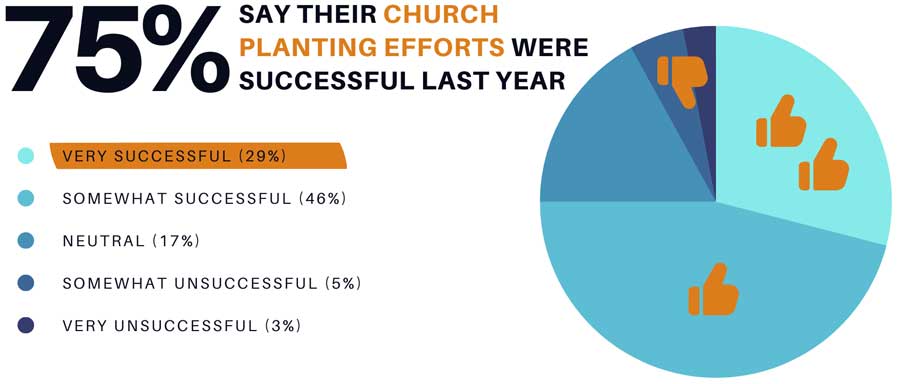
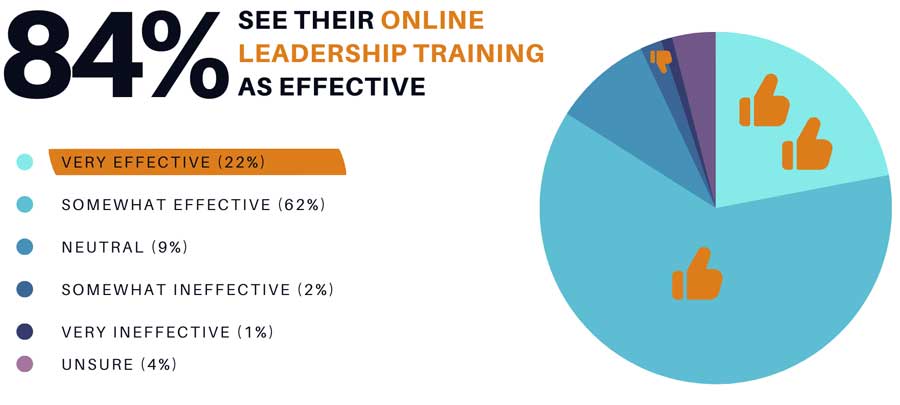

For those who are still struggling, these two groups can provide clear paths forward. Below, we’ll dive deeper into some of the habits of these two groups: the “very effective” online trainers, and the “very successful” church planters. Among these two groups, the survey highlighted numerous patterns that distinguished them from their peers. The good news is any church planter can implement them.
Statistical groups like these can be a little hard to connect with, so let’s unpack each one a little more and give them a (fictional) persona to add a little flesh and blood. Meet “Markos” and “Andrew."
Meet “Markos”—Our “Very Successful” Church Planter
“Markos” reported feeling “very successful” with his church planting efforts. Markos works for an organization that, like two-thirds (67%) of his “very successful” peers, is a member of GACX. Less successful respondents were less likely to be a part of GACX, an encouraging sign that GACX is creating better connections among church planting organizations for increased success.
Markos’ Beliefs and Plans
“Our training is on point—and preferably in-person.” When asked if they prefer either in-person or online training, 47% of those like Markos said “mostly in-person” training, a higher rate than any other group. Meanwhile, when it comes to what they are teaching, Markos feels confident that his organization is covering topics and content that people need. Only 5% of planters like Markos are questioning their content, whereas up to 70% of less successful church planters feel uncertain about the topics they cover in training.
More Comfortable, More Experimental. GACX asked church planters whether their organization are “comfortable” or “experimental” when it comes to church planting efforts—respondents could rate themselves on a 5-point spectrum between the two options. Here a more paradoxical finding emerged among the “very successful” church planters: Markos, and those like him, chose both extremes at significantly higher rates than their less successful peers. That is, they reported feeling that their organization was either fully “comfortable with current state” or fully “experimental,” but not in the middle.
That middle ground was more likely to be occupied by respondents who felt less successful. In fact, the less successful groups reported being “somewhat experimental” at very high rates. For Markos and his group, this was simply not the case—they chose “comfortable” or “experimental” and mostly avoided the middle ground.
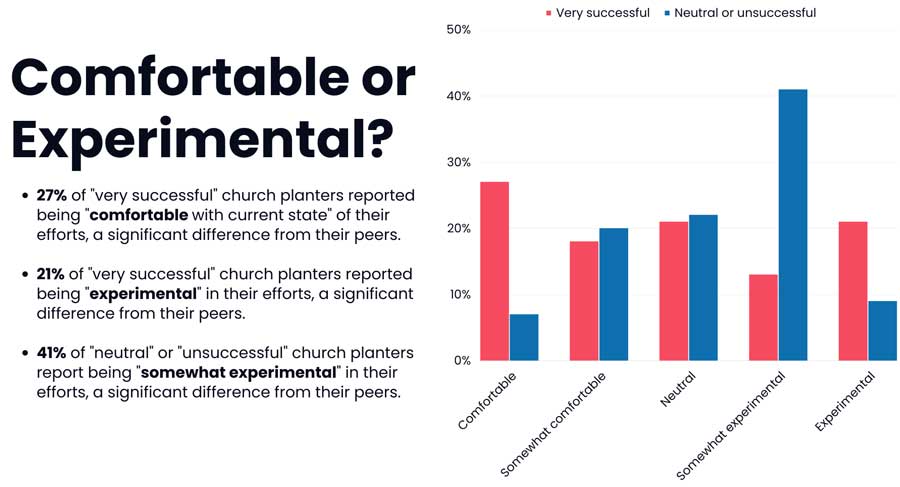
Where to Next? So where is Markos headed in the next two years? He and his “very successful” peers are looking towards South Asia (30%) and MENA (30%) for their future church planting efforts.
What Markos Does Differently
Now that we have a little insight into the mind of Markos, let’s move from his head to his hands and look at what habits and activities planters like him are succeeding with. The GACX survey homed in on two key dimensions of church planting: online leadership training, and technology usage. While church planting has many facets, in these two areas church planters have significant influence to improve the outcomes. Markos is evidence of this. Markos, as a “very successful” church planter, is doing a few things at higher rates than his less successful peers. Let’s look at training and technology in turn.

Coaching is Key. In terms of training, respondents like Markos reported using one thing—coaching—at significantly higher rates: 85% of church planters like Markos reported using coaching in their training, compared to 62% in other groups. While respondents were also asked about other training methods such as micro-learning, interactivity, real-world case studies, and assessments, the survey did not find planters like Markos to be using them at a higher rate that was statistically significant.
Thus, if you’re looking for one key method to level up your online leadership training, coaching is your best bet. The benefit here goes not just to your trainees either. Your coaches themselves will likely benefit from having to articulate their methods more cogently. The more they can explain and teach what they do, the more conscientious they will become in their own church planting efforts. Coaching is a win-win for your organization.
Mapping, Data, & Analytics are Key. The most common ways ministries are deciding where to plant new churches is through prayer (75%) and existing relationships (74%). But that isn’t necessarily making their efforts more successful. Markos and his peers are more likely to use mapping and data/analytics to plan where they should plant their next church. The group reported using mapping (69%) and data and analytics (50%) at significantly higher rates than their peers. (By contrast, neutral and “unsuccessful” church planters reported significantly lower rates of using data and analytics [26%]).
Furthermore, when asked which strategy they relied on most, the Markos group reported mapping (24%) and data and analytics (14%) at a significantly higher rate than less successful groups. Not only that, they were also significantly less likely to rely on existing relationships for such decisions.
Data-Informed Strategic Planning. In keeping with these findings, another distinctive quality is how the Markos group uses technology for church planting strategy, which is also tech-driven. At 48%, the Markos group relies on technology to research and decide what type of churches to plant significantly more than other groups. They also use technology, at somewhat higher rates, for “researching and identifying when and where to start a new church plant” (53%, emphasis added), for “pastoral care and counseling” (53%), and for “training and developing new leadership within the church plant” (73%).
Takeaways
Church planters like Markos are reaching into new territories by analyzing maps and data, rather than working within existing relational networks.
“Very successful” church planters are using data to inform when, where, and what type of churches to plant.
Data is giving Markos a view into areas outside existing networks. Planters like Markos are enabled to look beyond their network’s boundaries to see new places for church planting.
Church planters who are struggling in their church planting efforts might consider what data they could gather to inform their strategic planning.
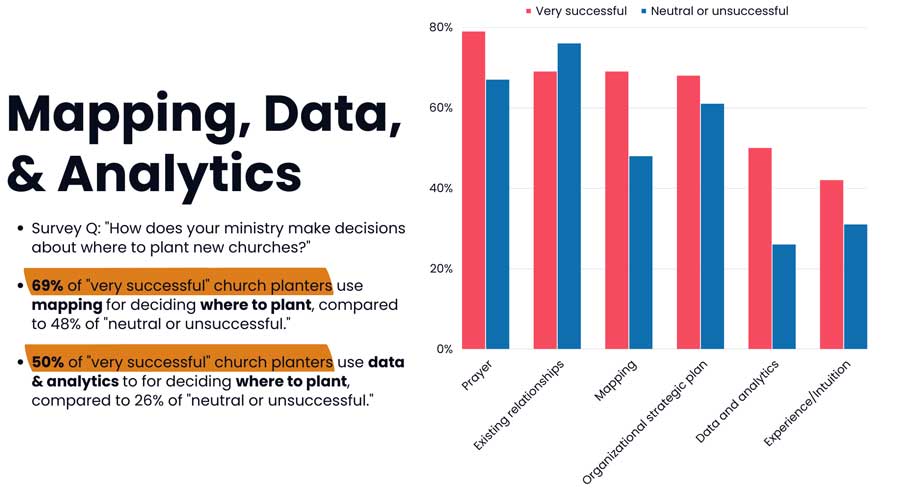
“The Right Tech” Isn’t Essential. While technology can certainly enable many new capacities, the lack of it should not dissuade struggling church planters. Our survey found that “having the right tech” is not a must for being successful. On the contrary, the Markos group “aren’t more likely to report they have the right technology in place.” Instead, church planters can start where they are with the technology they already have.
Use Tech For More Than Evangelism. Nor are struggling church planters novices when it comes to technology. In fact, 61% report using technology for marketing, evangelism, and outreach, a higher rate than their more “successful” counterparts at 47-56%. However, despite the higher rate, our research suggests that using technology for marketing or evangelism may not be its most valuable use.
In other words, less successful church planters are also using technology, but for less critical goals. Planters like Markos may be using technology more for other key areas. For example, less successful church planters are using technology at significantly lower rates for discipleship (54%), training and leadership development (46%), researching and identifying where and when to start a new church plant (35%), and researching and deciding what type of church to plant (19%). These rates (in parentheses) are significantly lower than church planters like Markos.
Takeaways
Struggling church planters may want to consider shifting technology investment away from marketing and evangelism and toward other strategies such as discipleship, leadership training, and research and decision-making.
If a ministry’s goal is connecting with UPGs, any shift away from evangelism may feel counterintuitive, but it leans into a multiplication strategy of investing in already-committed leaders and disciplers.
Investing in technology for discipleship, leadership training, and research and decision-making may be a longer play strategy for organizations, so leaders would need to accept and commit to a longer time horizon in their strategic planning.
Summary: Learning From “Very Successful” Church Planters
With these insights from the “very successful” church planters like Markos, leaders may already be seeing some new strategies taking shape in their minds: invest in coaching; use more mapping, data, and analytics for strategic planning like when, where, and what type of churches to plant; and shift technology investments from evangelism to discipleship, leader training, and research.
These priorities reflect what we’ve learned from planters like Markos, and the good news is we have another group of effective leaders to learn from: the “very effective” online leadership trainers. These trainers, whom we’re calling “Andrew,” can help round out some of these survey findings.
Meet “Andrew”—Our “Very Effective” Online Leadership Trainer
“Andrew” reports feeling “very effective” with online leadership training. Like 58% of his “very effective” peers, he would prefer to train 500 people online than 50 in person, and along with 25% of them, he believes “mostly online” training is the best strategy to plant churches globally “as quickly and effectively as possible.”
Andrew’s Beliefs and Plans
More Effective, More Interested. Effective online trainers like Andrew are more likely to want to do more online training. Conversely, less effective trainers are less likely to endorse large-scale online training—they preferred “building deeper relationships” over “having a broader reach.” These differences in experience and opinion may generate disagreements within organizations, especially when it comes to strategy. More successful trainers will want to train larger groups online. Less successful trainers will want to build deeper relationships. Leaders should be mindful of these opinions and how their own experiences might influence their own outlook.
Online Saves Time & Money. Andrew uses online training because it saves time and money. He would agree with one peer who wrote, “Online trainings accelerate times by making it more accessible in terms of time, costs.” Andrew may also believe, like another peer, that the motivation of the trainees is a big factor in his effectiveness: “people who have a legitimate passion and calling to plant churches are perfectly capable of receiving and implementing training online.”
Reaching Farther, More Quickly. Andrew uses online training because he is able “to provide training in difficult-to-reach locations” and to do it “more quickly” than they could otherwise. For Andrew, using technology seems strongly linked to feeling more effective in online leadership training.
Effective Training Overlaps Successful Planting. Lastly, and perhaps not surprisingly, Andrew is very likely to be in the same group as our second persona, “Markos,” the “very successful” church planter—Andrew and 94% of his “very effective” trainers reported as much. Now let’s look a little bit deeper at some of what Andrew is doing to make his online leadership training more effective than others’.
What Andrew Does Differently
Moving from Andrew’s head to his hands, here’s a look at what methods trainers like him are succeeding with.
Learning From Others. Andrew most likely didn’t start from scratch—he had help and caught a vision from others: 4 out of 5 (82%) very effective trainers had “seen a model and/or trends of how technology can effectively help facilitate church planting efforts.” For those wanting to get started, it is worthwhile to find others to learn from. And for those wanting to improve, simply doing more of it will certainly make a difference.
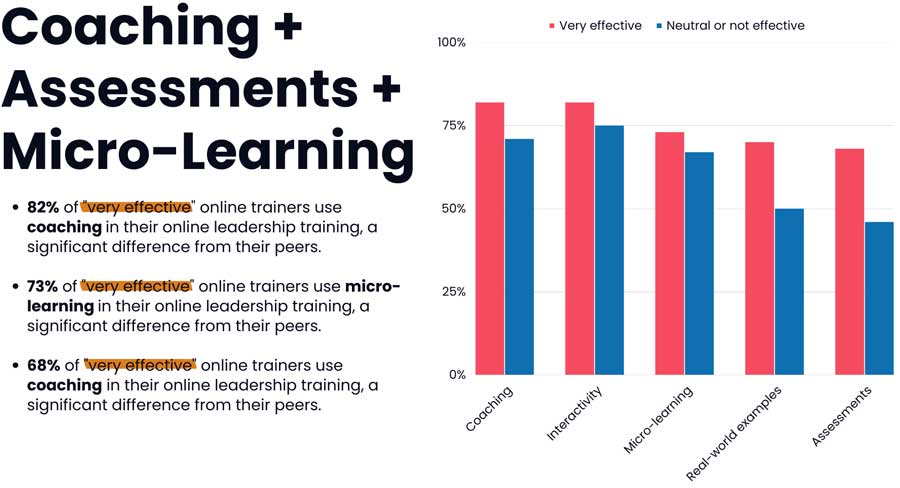
Coaching Is Key. Perhaps most important—Andrew has a number of things in common with Markos when it comes to training. You’ll recall that 85% of planters like Markos use coaching in their training, a significantly higher percentage. The same is true for online leadership trainers too. 82% of online trainers report using coaching in their training, a significantly higher rate.
Use Micro-Learning & Assessments. But the Andrews of online training are also doing a few other forms of training as well, also at significantly higher rates: micro-learning (73%) and assessments (68%). Rounding out the training methods are interactive approaches and real-world examples. Here also the Andrews were doing them more than their less effective counterparts, but not to a significant degree.
Relying More on Technology. When it comes to technology, both Andrew and Markos are significantly more likely to rely on technology to research and decide what types of churches to plant. Even so, only about 50% for both groups are using technology for decisions like this. That means technology presents a big growth area and tactical opportunity for both planters and trainers.
Takeaways
“Very effective” online leadership trainers like Andrew are using coaching, micro-learning, and assessments at significantly higher rates than less effective trainers.
For both Markos and Andrew, coaching is helping to produce more successful and more effective results in their church planting efforts.
For less effective planters and trainers, adding more coaching to the repertoire should be a top priority.
For research and decision-making, both groups should consider technology as a potential tool to add to their strategy-building toolkit. Adding it will reshape how both research and decision-making happen—including what factors are considered, and which ones may get overlooked—so leaders should plan carefully and articulate their own core values when setting out.
Summary: Learning from “Very Effective” Online Leadership Trainers
As you’ll no doubt notice, “Andrew” affirms the evidence we already had from “Markos”—coaching is crucial, and mapping, data, and analytics can effectively inform what types of churches to plant. But Andrew goes further than Markos as well: they report more effective online leadership training not only with more coaching but also with more micro-learning and assessments. For struggling church planters or online trainers, these findings chart a course toward greater effectiveness.
A New Kind of Decision-Making
Evaluating your data sources is important. Making decisions based on digital data sources is very different from deciding based on your organization’s strategic plan. Hearing God’s leading in prayer is a very different approach from looking at maps, charts, and graphs. Using technology will influence what data you account for and what data you overlook. The data you gather will influence the strategies you create.
This shift may concern some leaders—and it should be evaluated critically—but the increased use of technology and data can be seen as supplementing—rather than replacing—prayer, relationships, and strategic vision. In fact, the more intentional leaders are with incorporating digital methods, the more they can influence how this new decision-making takes shape.
Prayer Inspired, Data Informed. How might digital methods be used to test and approve prayer-filled visions? In prayer, leaders may feel called to pursue a new area of ministry and outreach. In a case like that, such leaders could then turn to mapping, data, and analytics to give them a clearer understanding of what challenges they might face. Or they might use such methods to help them shape a strategy that is more likely to succeed—including determining when, where, and/or what type of church to plant.
Alternatively, another approach for some leaders may be to gather spreadsheets of data and learn as much as possible about various trends and potential leading indicators of God’s movement in a region. With this data in hand, such leaders could then commit to prayerfully asking God what insights he would have them draw from this information. Such prayerful reflection may lead them to delve deeper in one area or another to learn more, and trusting the Spirit’s leading, ultimately decide where they will go next.
These two approaches are just two of many ways that church planters and online trainers could lead their teams to making decisions that are data-informed and Spirit-driven.
Conclusion
God Gives the Increase. Reviewing the State of Global Church Planting, the first thing you can do is give thanks to God for “making our efforts successful.” As this GACX survey has demonstrated, most leaders are feeling successful in church planting and effective in online leadership training. 75% of respondents reported that their church planting efforts feel successful, and 84% said they see their online leadership training as effective. Beyond that, 94% of respondents reported collaborating with other ministries. We can praise God for showing himself faithful as we have worked to respond to his call to plant gospel churches globally. By his Spirit, God has coordinated many different people and organizations to advance his church for the sake of the world. This survey captures a glimpse of that.
Key Takeaways. Second, leaders can take away a couple additional insights.
Find models to learn from. 82% of online leadership trainers saw it modeled for them. This fact reinforces what we’ve already seen here: coaching is powerfully effective.
Upgrade your training with coaching, micro-learning, and assessments. If they’re not working well for you, GACX can connect you with organizations for whom they are.
Upgrade your strategic planning with mapping, data, and analytics. Clarify the question(s) you’re trying to answer, then find the tools that will help you answer them. If you’re researching, identifying, and/or deciding when, where, and/or what type of churches to plant, make sure you’re utilizing tools like these.
Address Challenges. Finally, we listed, at the start, what church planters told us their biggest challenges they are right now: language barriers (44%), establishing relationships and growing them (36%), low training attendance and completion rates (34%), budget limitations (29%), and difficulty tracking success (28%).
While our survey findings don’t remove all these hurdles, it may help clear some of them out of the way. For example,
Increased coaching may improve low training attendance and completion rates—participants may value the increased investment of a coach and feel an increased responsibility to honor their coach’s time.
Coaching could also have a down-stream effect by helping planters to more successfully establish and grow relationships.
Using assessments might help organizations track success more clearly—trainers can better see what their participants are learning or failing to grasp.
Language barriers and budget limitations we may always have with us, but if we can learn from Markos’ success and Andrew’s effectiveness, church planters and online trainers will continue to see their work bearing fruit by the grace of God.
